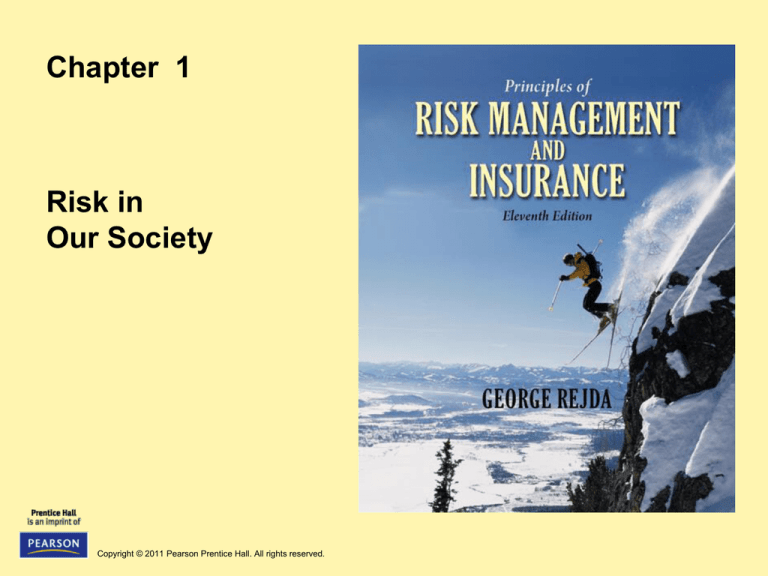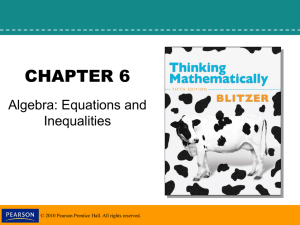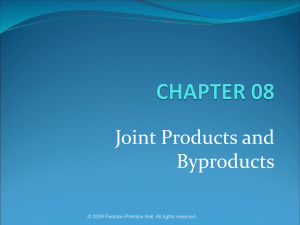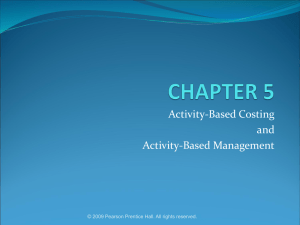
Chapter 1
Risk in
Our Society
Copyright © 2011 Pearson Prentice Hall. All rights reserved.
Agenda
•
•
•
•
•
•
•
Different Definitions of Risk
Chance of Loss
Peril and Hazard
Classification of Risk
Major Personal Risks and Commercial Risks
Burden of Risk on Society
Techniques for Managing Risk
Copyright © 2011 Pearson Prentice Hall. All rights reserved.
1-2
Different Definitions of Risk
• Risk: Uncertainty concerning the occurrence of a loss
• Loss Exposure: Any situation or circumstance in which a loss
is possible, regardless of whether a loss occurs.
• Objective Risk vs. Subjective Risk
– Objective risk is defined as the relative variation of actual loss
from expected loss
• It can be statistically calculated using a measure of dispersion, such
as the standard deviation
– Subjective risk is defined as uncertainty based on a person’s
mental condition or state of mind
• Two persons in the same situation may have different perceptions of
risk
• High subjective risk often results in conservative behavior
Copyright © 2011 Pearson Prentice Hall. All rights reserved.
1-3
Chance of Loss
• Chance of loss: The probability that an event will occur
• Objective Probability vs. Subjective Probability
– Objective probability refers to the long-run relative frequency of
an event assuming an infinite number of observations and no
change in the underlying conditions
• It can be determined by deductive or inductive reasoning
– Subjective probability is the individual’s personal estimate of
the chance of loss
• A person’s perception of the chance of loss may differ from the
objective probability
Copyright © 2011 Pearson Prentice Hall. All rights reserved.
1-4
Peril and Hazard
• A peril is defined as the cause of the loss
– In an auto accident, the collision is the peril
• A hazard is a condition that increases the chance of loss
– Physical hazards are physical conditions that increase the chance
of loss (icy roads, defective wiring)
– Moral hazard is dishonesty or character defects in an individual,
that increase the chance of loss (faking accidents, inflating claim
amounts)
– Attitudinal Hazard (Morale Hazard) is carelessness or indifference
to a loss, which increases the frequency or severity of a loss
(leaving keys in an unlocked car)
– Legal Hazard refers to characteristics of the legal system or
regulatory environment that increase the chance of loss (large
damage awards in liability lawsuits)
Copyright © 2011 Pearson Prentice Hall. All rights reserved.
1-5
Classification of Risk
• Pure and Speculative Risk
– A pure risk is one in which there are only the possibilities of loss
or no loss (earthquake)
– A speculative risk is one in which both profit or loss are possible
(gambling)
• Diversifiable Risk and Nondiversifiable Risk
– A diversifiable risk affects only individuals or small groups (car
theft). It is also called nonsystematic or particular risk.
– A nondiversifiable risk affects the entire economy or large
numbers of persons or groups within the economy (hurricane). It
is also called systematic risk or fundamental risk.
– Government assistance may be necessary to insure
nondiversifiable risks.
Copyright © 2011 Pearson Prentice Hall. All rights reserved.
1-6
Classification of Risk
• Enterprise risk encompasses all major risks faced by a
business firm, which include: pure risk, speculative risk,
strategic risk, operational risk, and financial risk
– Financial Risk refers to the uncertainty of loss because of
adverse changes in commodity prices, interest rates, foreign
exchange rates, and the value of money.
• Enterprise Risk Management combines into a single unified
treatment program all major risks faced by the firm:
–
–
–
–
–
Pure risk
Speculative risk
Strategic risk
Operational risk
Financial risk
Copyright © 2011 Pearson Prentice Hall. All rights reserved.
1-7
Major Personal Risks and
Commercial Risks
• Personal risks involve the possibility of a
loss or reduction in income, extra
expenses or depletion of financial assets:
– Premature death of family head
– Insufficient income during retirement
• Most workers are not saving enough for a comfortable
retirement
– Poor health (catastrophic medical bills and loss
of earned income)
– Involuntary unemployment
Copyright © 2011 Pearson Prentice Hall. All rights reserved.
1-8
Exhibit 1.1 Reported Total Savings and
Investments among Those Responding, by Age
(not including value of primary residence or defined benefit plans)
Copyright © 2011 Pearson Prentice Hall. All rights reserved.
1-9
Major Personal Risks and
Commercial Risks
• Property risks involve the possibility of losses
associated with the destruction or theft of
property:
– Physical damage to home and personal property from fire,
tornado, vandalism, or other causes
• Direct loss vs. indirect loss
– A direct loss is a financial loss that results from the physical
damage, destruction, or theft of the property, such as fire
damage to a home
– An indirect loss results indirectly from the occurrence of a direct
physical damage or theft loss, such as the additional living
expenses after a fire to a home. These additional expenses
would be a consequential loss.
Copyright © 2011 Pearson Prentice Hall. All rights reserved.
1-10
Major Personal Risks and
Commercial Risks
• Liability risks involve the possibility of being held
liable for bodily injury or property damage to
someone else
– There is no maximum upper limit with respect to the
amount of the loss
– A lien can be placed on your income and financial assets
– Defense costs can be enormous
Copyright © 2011 Pearson Prentice Hall. All rights reserved.
1-11
Major Personal Risks and
Commercial Risks
• Commercial Risks
– Firms face a variety of pure risks that can have serious
financial consequences if a loss occurs:
• Property risks, such as damage to buildings, furniture and
office equipment
• Liability risks, such as suits for defective products, pollution of
the environment, and sexual harassment
• Loss of business income, when the firm must shut down for
some time after a physical damage loss
• Other risks to firms include crime exposures, human resource
exposures, foreign loss exposures, intangible property
exposures, and government exposures
Copyright © 2011 Pearson Prentice Hall. All rights reserved.
1-12
Burden of Risk on Society
• The presence of risk results in three major
burdens on society:
– In the absence of insurance, individuals would
have to maintain large emergency funds
– The risk of a liability lawsuit may discourage
innovation, depriving society of certain goods
and services
– Risk causes worry and fear
Copyright © 2011 Pearson Prentice Hall. All rights reserved.
1-13
Techniques for Managing Risk
• There are five major methods for managing risk
– Avoidance
– Loss control
• Loss prevention refers to activities to reduce the frequency of losses
• Loss reduction refers to activities to reduce the severity of losses
– Retention
• An individual or firm retains all or part of a given risk
• Active retention means that an individual is consciously aware of the
risk and deliberately plans to retain all or part of it
• Passive retention means risks may be unknowingly retained because
of ignorance, indifference, or laziness
• Self Insurance is a special form of planned retention by which part or
all of a given loss exposure is retained by the firm
Copyright © 2011 Pearson Prentice Hall. All rights reserved.
1-14
Techniques for Managing Risk
• Noninsurance transfers
– A risk may be transferred to another party by several methods:
– A transfer of risk by contract, such as through a service
contract or a hold-harmless clause in a contract
– Hedging is a technique for transferring the risk of unfavorable
price fluctuations to a speculator by purchasing and selling
futures contracts on an organized exchange
– Incorporation of a business firm transfers to the creditors the
risk of having insufficient assets to pay business debts
• Insurance
– For most people, insurance is the most practical method for
handling a major risk
Copyright © 2011 Pearson Prentice Hall. All rights reserved.
1-15












